Traditional Sauna - The Facts
Traditional Sauna - The Facts
Blog Article
The Main Principles Of Traditional Sauna
Table of ContentsAll About Traditional SaunaHow Traditional Sauna can Save You Time, Stress, and Money.Getting My Traditional Sauna To WorkSome Ideas on Traditional Sauna You Need To Know
The majority of the weight shed in a sauna is water loss and is re-gained upon rehydrating. However, undeniably sauna can be a crucial component of a healthy and balanced weight-loss program. To check out the distinctions in between typical and IR saunas, I will certainly separate these right into proven, academic, and made differences.Thus, the hottest point in the saunawhich goes to the ceiling straight above the sauna heateris normally between 185 and 190 F. Traditional Sauna. Claims that a standard sauna surpasses 200 F is just not real and not applicable for electric saunas offered in the US. The temperature for a far-infrared sauna is normally set in between 120 and 140 F; nonetheless, unlike the typical sauna, the objective in and IR room is not to attain a high temperature level
Due to the fact that of this, the temperature level difference is nearly pointless, considering that excessive sweating results in both sauna kinds, but the technique of heating up the body is various. In an IR sauna the bather will really feel warm and will certainly sweat profusely, but at a lot lower temperatures. Therefore, if the goal is to spend longer time periods in the sauna, the IR sauna is a great choice.

Rumored Buzz on Traditional Sauna
When the high temperature is attained, the elements cycle on and off to maintain the high temperature level. A lot of traditional sauna individuals delight in pouring water over the rocks to develop vapor to increase sauna moisture degrees. The advantages of putting water over the rocks consist of: making the area more comfy, moistening the nasal passages, and allowing the use of aromatherapy by blending necessary oils with the water.
In a far-infrared sauna, the warm front penetrate the body to successfully heat the body and raise the body core temperature level. To accomplish this enhanced temperature, Far-infrared emitters create infrared energy which is close to the exact same wavelength as that which the body normally emitsoften described as the "Vital Array" of 7 to 14 microns), so the power is well received by the body.
When the power goes into the body, it causes the body temperature to increase and eventually results in perspiration. In an infrared sauna it is very important for the emitters/heaters to remain on nearly constantly. Because there is no mass of rocks to keep heat, the sauna will cool if the emitters turned off.
As mentioned above, the sauna bather in an infrared area intends to position himself before running emitters to obtain maximum gain from the warm. The home heating time for the 2 spaces can be extremely various, depending upon how the rooms are utilized. For a typical sauna, a bather ought to enable 30-40 minutes for the space to achieve a preferred temperature level and to correctly pre-heat the rocks.
A Biased View of Traditional Sauna
A well built sauna will generally accomplish a temperature level of 150-160 F in about 30-40 minutes. For hotter temperatures, the space might require to warmth for a longer duration.
To some, 15 mins was "wasted" while the infrared energy heated the wood panels instead than heating a body, while others discover a pre-heated space to be a lot more comfy and think an elevated starting temperature is required like it to start perspiring. The length of recommended use for each room is around the very same (10-15 mins per session); nonetheless, as a result of the lower air temperature levels and the capacity to really feel the results of infrared warmth quicker than a standard sauna, it is not unusual for an individual to invest a total amount of 20-30 mins in an infrared sauna.
Standard saunas often tend to be larger (for this reason utilize even more electrical energy) than infrared saunas, although standard saunas are definitely available in one and two person dimensions. For a two-person standard sauna, 5x6 or 5x7 size is most preferred. The leading bench can pleasantly seat 2 or three individuals and is additionally long sufficient to relax during the sauna session.


The typical cost per kWH of electrical energy in the U.S. is roughly $0.11, so a 4.5 kW heating system will set you back roughly $.50 to run for one hour, if the heating system runs continually for one hour. Commonly a sauna heating unit will certainly run for 75% of the very first hour and 50% of subsequent hours on considering that the elements cycle once the set temperature i was reading this level is accomplished.
Getting The Traditional Sauna To Work
A 2 individual far-infrared space is usually physically smaller than a standard sauna, typically about 4' x 4' or smaller. The IR heating unit is usually 1.5-1.7 kW utilizing a 120 volt 15 amp plug-in solution. Because the space can be utilized quicker than a sauna space, we will certainly assume the room is find more info used for to of an hour consisting of warm up time.
There is a hardly ever discussed distinction in the social experience in between the 2 spaces. While our society has actually lost some of the social benefit of the conventional sauna experience, it can be extremely socially satisfying. From household time in the sauna, to heart-felt conversations with better halves, to sauna partiesthe standard sauna experience can cause intimate interacting socially.
Most greater end infrared rooms consist of tinted light therapy, audio systems and full-glass fronts.
Report this page